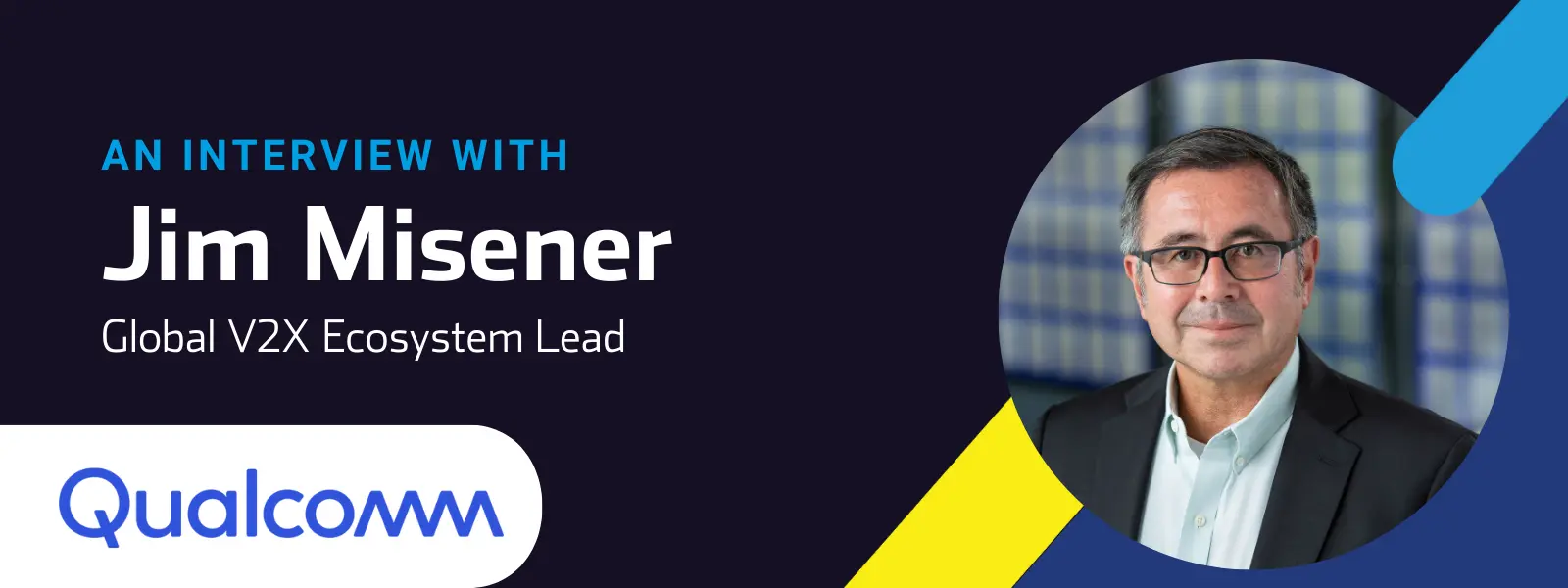Hear from Jim Misener, Global V2X Ecosystem Lead for Qualcomm. In this interview Jim shares with us his views on the role of connected vehicles in smart city planning, including collaborative efforts across the industry towards a seamless global V2X ecosystem. Jim will be joining us at AutoSens USA for a fireside chat on how V2X technologies are shaping the automotive landscape with David L. Howard – find out more here.
1. In the rapidly evolving landscape of smart city planning and transportation innovation, what role does Qualcomm envision for V2X/CV2X technologies? How does the company foresee shaping the future of connected vehicles and their integration into urban environments?
This is a great question, because we at Qualcomm Technologies, Inc. recognize that a big component of smart city planning is understanding and being part of the larger ecosystem of Federal, State and regional investments, but in the end, transportation implementation is local – and it happens on the ground with cities and other local agencies. Moreover, planning horizon span several decades and all the while the automotive industry and mobility in general evolves. How is a planner to deal with such innovation? Qualcomm Technologies recognizes that a significant component of the innovation will be in communications. Cars will talk to each other and also to the cloud – and before that, travelers will know via cloud services whether and when to take certain modes. The bottom line is, they will want to travel from point A to point B safely and efficiency.
Let’s start with safety. Qualcomm Technologies believes that deploying V2X technologies will be essential for providing actionable safety information in near real-time, not only for the local agency, but ultimately to each traveler. That’s because V2X allows vehicles to communicate directly with other vehicles, infrastructure, and someday vulnerable road users—such as pedestrians and cyclists—without the involvement of a cellular network, providing real-time data to inform applications that can have an immediate impact on safety.
Complementing V2X with cellular and cloud connectivity will bring enormous benefits to urban environments. When harnessed in a centralized cloud-connected repository, the highly accurate and granular data generated from V2X exchanges can inform services and operations such as traffic signal actuation that enhance transportation system management and fleet operations, and personal travel experiences.
Cloud and V2X data provide transportation planners with insights into demand, helping them to determine optimal deployment of transportation infrastructure, advanced transit services, and placement of ITS-enabled transportation pricing and demand management equipment such as electronic road user charging or variable parking fees.
Emerging use cases for V2X data include electronic toll collection for a better user experience and less starting and stopping to reduce congestion, freight signal priority for more efficient delivery of goods, and mobility-on-demand services for more timely and efficient travel experiences.
2. As the automotive industry undergoes a transformative shift toward connectivity, could you share insights into collaborative efforts with other stakeholders, including automakers and city planners? How are these efforts contributing to the creation of a seamless and intelligent V2X ecosystem on a global scale?
Many in the public and private sectors have come together to accelerate the deployment of safety services, demonstrating business and technical paths to deployment and providing insight into how to develop this pivotal technology and make it commercially viable and scalable for automakers, government agencies, and infrastructure providers. Below are examples of deployments that use Qualcomm C-V2X technology.
In recent months, the USDOT has been developing a national C-V2X deployment plan with inputs received from multiple stakeholders. In tandem, they have awarded a host of C-V2X deployment projects, for example a mid-block pedestrian warning system in the City of Chattanooga. We at Qualcomm Technologies are proud to be part of this pioneering lighthouse project along with VW Group and HARMAN. The USDOT has also started a national competition called the C-V2X Accelerator Grant. The winners have not been announced, but there is considerable interest amongst jurisdictions to establish broad local and regional deployments. Some of the interested entities and partners include automotive and truck OEMs, as they realized that a vehicle deployment needs to have hospitable infrastructure for vehicle to infrastructure (V2I) safety. While the final USDOT plan has not been revealed, the initial indication is that in 10 or so years, 85% of signalized intersections in the top 75 metro areas will be equipped with C-V2X, so yes, the infrastructure will talk to and listen to cars, and the safety and mobility benefits discussed in my answer to the previous question can be realized.
3. How does Qualcomm’s leadership in the Global V2X Ecosystem position the company as a driving force in automotive innovation? Can you highlight specific technologies or initiatives that underscore Qualcomm’s dedication to advancing V2X/CV2X technologies?
As a leader in the global V2X ecosystem, Qualcomm Technologies is positioned to continue investing in V2X research, development and deployment. In addition to our suite of V2X products within the Snapdragon Digital Chassis, Qualcomm Technologies has enabled collaborations to demonstrate and create modern V2X solutions, with recent examples including collaboration with the technical community – OEMs and infrastructure owner-operators alike – to develop interoperable standards and protocols which underlie deployment.
…and to sample but a few of our initiatives with deploying stakeholders:
- Work with Commsignia to showcase the immediate impact of V2X on the streets of Las Vegas at CES 2023, demonstrating how drivers and transportation agencies benefit when information is exchanged between vehicles and infrastructure in real-time.
- Initiative with Spoke – a mobility platform for safety, connectivity, and rich rider experiences – to integrate their C-V2X solution to connect micro-mobility users such as cyclists and scooter riders, who are Vulnerable Road Users (VRUs) that can benefit from C-V2X.
- Work with the City of Bellevue, T-Mobile, and Applied Information to demonstrate how a cloud-connected midblock pedestrian crossing installation can be augmented with connectivity to make pedestrians more noticeable to all vehicles in the area.
4. Why is it important to bring together experts in ADAS and AVS with those working on V2X initiatives at AutoSens? What are you most looking forward to about the conference?
Today’s cameras, sensors, and driver assistance features are making modern vehicles smarter and safer than ever before. However, these sensors typically only keep vehicles safe in their immediate surroundings. C-V2X can supplement these on-board sensors by effectively allowing vehicles to see around blind corners and other types of obstructions – and alert the driver toother vehicles. Because C-V2X connects vehicles and roadside infrastructure that are not in each other’s line of sight, it allows them to share short range broadcast information about traffic signals, thereby improving road safety and make entire transportation systems more efficient. I’m looking forward to sharing my perspective on how V2X can be deployed alongside on-board safety technologies to advance connected infrastructure and make road users safer than ever before.
Don’t miss the fireside chat with Jim on ‘Shaping the Global Automotive Landscape with V2X Technologies’ at AutoSens USA 2024. Click here to see the full agenda.









